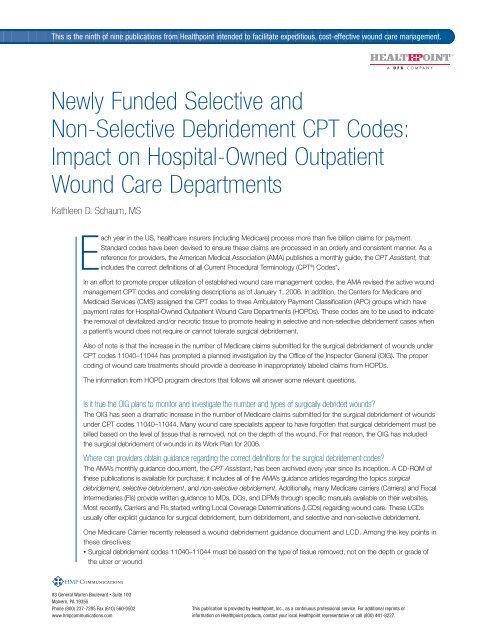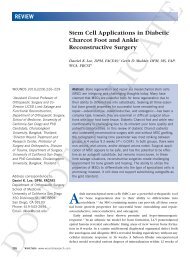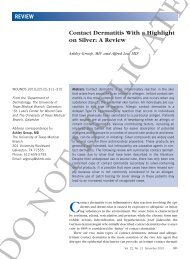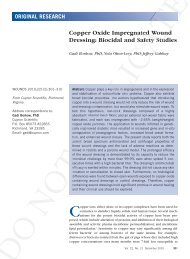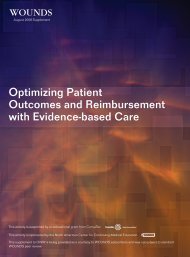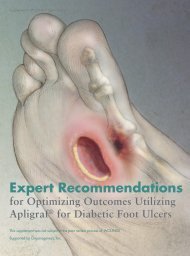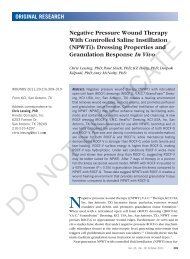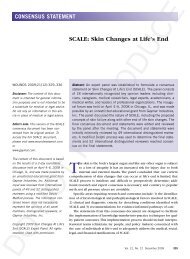Newly Funded Selective and Non-Selective Debridement CPT ...
Newly Funded Selective and Non-Selective Debridement CPT ...
Newly Funded Selective and Non-Selective Debridement CPT ...
Create successful ePaper yourself
Turn your PDF publications into a flip-book with our unique Google optimized e-Paper software.
This is the ninth of nine publications from Healthpoint intended to facilitate expeditious, cost-effective wound care management.<br />
<strong>Newly</strong> <strong>Funded</strong> <strong>Selective</strong> <strong>and</strong><br />
<strong>Non</strong>-<strong>Selective</strong> <strong>Debridement</strong> <strong>CPT</strong> Codes:<br />
Impact on Hospital-Owned Outpatient<br />
Wound Care Departments<br />
Kathleen D. Schaum, MS<br />
Each year in the US, healthcare insurers (including Medicare) process more than five billion claims for payment.<br />
St<strong>and</strong>ard codes have been devised to ensure these claims are processed in an orderly <strong>and</strong> consistent manner. As a<br />
reference for providers, the American Medical Association (AMA) publishes a monthly guide, the <strong>CPT</strong> Assistant, that<br />
includes the correct definitions of all Current Procedural Terminology (<strong>CPT</strong> ® ) Codes*.<br />
In an effort to promote proper utilization of established wound care management codes, the AMA revised the active wound<br />
management <strong>CPT</strong> codes <strong>and</strong> correlating descriptions as of January 1, 2006. In addition, the Centers for Medicare <strong>and</strong><br />
Medicaid Services (CMS) assigned the <strong>CPT</strong> codes to three Ambulatory Payment Classification (APC) groups which have<br />
payment rates for Hospital-Owned Outpatient Wound Care Departments (HOPDs). These codes are to be used to indicate<br />
the removal of devitalized <strong>and</strong>/or necrotic tissue to promote healing in selective <strong>and</strong> non-selective debridement cases when<br />
a patient’s wound does not require or cannot tolerate surgical debridement.<br />
Also of note is that the increase in the number of Medicare claims submitted for the surgical debridement of wounds under<br />
<strong>CPT</strong> codes 11040–11044 has prompted a planned investigation by the Office of the Inspector General (OIG). The proper<br />
coding of wound care treatments should provide a decrease in inappropriately labeled claims from HOPDs.<br />
The information from HOPD program directors that follows will answer some relevant questions.<br />
Is it true the OIG plans to monitor <strong>and</strong> investigate the number <strong>and</strong> types of surgically debrided wounds<br />
The OIG has seen a dramatic increase in the number of Medicare claims submitted for the surgical debridement of wounds<br />
under <strong>CPT</strong> codes 11040–11044. Many wound care specialists appear to have forgotten that surgical debridement must be<br />
billed based on the level of tissue that is removed, not on the depth of the wound. For that reason, the OIG has included<br />
the surgical debridement of wounds in its Work Plan for 2006.<br />
Where can providers obtain guidance regarding the correct definitions for the surgical debridement codes<br />
The AMA’s monthly guidance document, the <strong>CPT</strong> Assistant, has been archived every year since its inception. A CD-ROM of<br />
these publications is available for purchase; it includes all of the AMA’s guidance articles regarding the topics surgical<br />
debridement, selective debridement, <strong>and</strong> non-selective debridement. Additionally, many Medicare carriers (Carriers) <strong>and</strong> Fiscal<br />
Intermediaries (FIs) provide written guidance to MDs, DOs, <strong>and</strong> DPMs through specific manuals available on their websites.<br />
Most recently, Carriers <strong>and</strong> FIs started writing Local Coverage Determinations (LCDs) regarding wound care. These LCDs<br />
usually offer explicit guidance for surgical debridement, burn debridement, <strong>and</strong> selective <strong>and</strong> non-selective debridement.<br />
One Medicare Carrier recently released a wound debridement guidance document <strong>and</strong> LCD. Among the key points in<br />
these directives:<br />
• Surgical debridement codes 11040–11044 must be based on the type of tissue removed, not on the depth or grade of<br />
the ulcer or wound<br />
83 General Warren Boulevard • Suite 100<br />
Malvern, PA 19355<br />
Phone (800) 237-7285 Fax (610) 560-0502<br />
www.hmpcommunications.com<br />
This publication is provided by Healthpoint, Inc., as a continuous professional service. For additional reprints or<br />
information on Healthpoint products, contact your local Healthpoint representative or call (800) 441-8227.
• Surgical debridement will be considered as “not medically<br />
necessary” when documentation indicates the wound is without<br />
infection, necrosis, or nonviable tissues <strong>and</strong> has pink to red granulated<br />
tissue<br />
• <strong>CPT</strong> code 11042 is defined as debridement; skin <strong>and</strong><br />
subcutaneous tissue. Wound care providers are using this code<br />
incorrectly when they are removing fibrin, which is not skin. To bill<br />
the code 11042, the Carrier expects the provider to debride skin<br />
<strong>and</strong> subcutaneous tissue — eg, when only necrotic skin <strong>and</strong><br />
subcutaneous tissue are debrided, even though the ulcer or wound<br />
might extend to bone<br />
• The Carrier states that an individual wound would not be expected<br />
to be repeatedly debrided of skin <strong>and</strong> subcutaneous tissue<br />
because these tissues do not regrow very quickly.<br />
Be sure to check your Carrier’s <strong>and</strong>/or your FI’s website for any LCDs<br />
that pertain to surgical debridement.<br />
Several years ago, the AMA released active wound management<br />
codes to be used by nurses <strong>and</strong> physical therapists when they<br />
removed devitalized <strong>and</strong>/or necrotic tissue from wounds to promote<br />
healing. However, those codes did not have payment rates for HOPDs.<br />
Therefore, HOPDs had two choices: include this work into their clinic<br />
visit levels or request that physicians perform the debridements. Are the<br />
active wound management codes still unfunded for HOPDs<br />
Effective January 1, 2006, the AMA revised the active wound<br />
management <strong>CPT</strong> codes <strong>and</strong> descriptions. Simultaneously, the<br />
CMS assigned the <strong>CPT</strong> codes to APC groups which have<br />
payment rates for HOPDs. The new/revised active wound<br />
management <strong>CPT</strong> codes are:<br />
97597: Removal of devitalized tissue from wound(s), selective<br />
debridement, without anesthesia (eg, high pressure waterjet<br />
with/without suction, sharp selective debridement with scissors,<br />
scalpel, <strong>and</strong> forceps), with or without topical application(s), wound<br />
assessment, <strong>and</strong> instruction(s) for ongoing care, may include use of a<br />
whirlpool, per session; total wound(s) surface area < 20 cm 2 .<br />
TABLE 1<br />
97598: Removal of devitalized tissue from wound(s), selective<br />
debridement, without anesthesia (eg, high pressure waterjet<br />
with/without suction, sharp selective debridement, with scissors,<br />
scalpel <strong>and</strong> forceps), with or without topical application(s), wound<br />
assessment, <strong>and</strong> instruction(s) for ongoing care, may include use of a<br />
whirlpool, per session; total wound(s) surface area >20 cm 2 .<br />
97602: Removal of devitalized tissue from wound(s), non-selective<br />
debridement, without anesthesia (eg, wet-to-moist dressings,<br />
enzymatic, abrasion), including topical application(s), wound<br />
assessment, <strong>and</strong> instruction(s) for ongoing care, per session.<br />
The 2006 APC group assignments <strong>and</strong> national unadjusted payment<br />
rates are shown in Table 1.<br />
When should an HOPD use these new codes<br />
The active wound management procedures are performed to<br />
remove devitalized <strong>and</strong>/or necrotic tissue <strong>and</strong> to promote healing.<br />
These selective <strong>and</strong> non-selective debridement codes are used<br />
when a patient’s wound does not require surgical debridement or if a<br />
patient cannot tolerate surgical debridement. The provider also is<br />
required to have direct (one-on-one) patient contact.<br />
Many HOPDs include selective <strong>and</strong> non-selective debridements into<br />
their clinic visit level mapping system. What should the HOPD do now<br />
that these procedures have uniquely defined <strong>and</strong> funded <strong>CPT</strong> codes<br />
The HOPD program director should remove all selective <strong>and</strong><br />
non-selective debridement services from the clinic visit level mapping<br />
system. Simultaneously, the program director should add codes<br />
97597, 97598, <strong>and</strong> 97602 to the chargemaster <strong>and</strong> the charge<br />
sheets. To ensure compliance, the program director should in-service<br />
staff regarding the various procedures <strong>and</strong> products included in each<br />
of the newly funded active wound management codes.<br />
To clarify: if the patient’s wound needs to be debrided or the patient<br />
cannot tolerate surgical debridement <strong>and</strong> the physician orders the<br />
application of an enzymatic debrider, the HOPD should bill for 97602<br />
rather than a clinic visit.<br />
<strong>CPT</strong> Code APC Group National Unadjusted National Unadjusted Minimum Unadjusted<br />
Medicare Payment Rate Medicare Copayment Medicare Copayment<br />
97597<br />
97598<br />
97602<br />
0012 Level I <strong>Debridement</strong><br />
<strong>and</strong> Destruction<br />
0013 Level II <strong>Debridement</strong><br />
<strong>and</strong> Destruction<br />
0340 Minor Ancillary<br />
Procedures<br />
$50.45 $11.18 $10.09<br />
$63.10 $13.07 $12.52<br />
$36.52 — $7.30<br />
TABLE 2<br />
<strong>CPT</strong> Code In-Office National In-Office National In-Facility National In-Facility National<br />
Average Medicare Average Medicare Average Medicare Average Medicare<br />
Payment Rate Copayment Rate Payment Rate Copayment Rate<br />
97597 $48.89 $9.78 NA NA<br />
97598 $62.15 $12.43 NA NA<br />
97602 0 0 0 0
Must the HOPD purchase the enzymatic debrider used on the patient<br />
or can the patient bring the enzymatic debrider from home<br />
Like all APC procedures, dressings <strong>and</strong> drugs are bundled into the<br />
payment for the procedure. Therefore, the HOPD is required to<br />
purchase the enzymatic debrider <strong>and</strong> the dressings used on the day<br />
of HOPD care. The drugs <strong>and</strong> dressings patients acquire for home<br />
use should be left at home. NOTE: the enzymatic debriders <strong>and</strong><br />
dressings should not be samples.<br />
How does the HOPD bill when the wound specialist applies an<br />
enzymatic debrider to more than one wound<br />
The code 97602 should be billed only once per HOPD visit, even if<br />
an enzymatic debrider is applied to multiple wounds on a patient.<br />
Some HOPDs are staffed only by wound care nurses. Can the HOPD<br />
bill 97602 if a wound care nurse applies an enzymatic debrider<br />
ordered by the physician<br />
Yes. The HOPD can bill for 97602 when a wound care nurse applies<br />
an enzymatic debrider.<br />
Is it acceptable for an HOPD to bill a clinic visit <strong>and</strong> the<br />
selective/non-selective debridement codes on the same day What<br />
about surgical debridement <strong>and</strong> selective/non-selective debridement<br />
codes on the same day<br />
No. Neither of these scenarios is allowed under the current system.<br />
The HOPD can bill one or the other but not both.<br />
Is it true that the selective <strong>and</strong> non-selective debridement codes are<br />
not funded by Medicare for physicians<br />
Yes <strong>and</strong> no. On one h<strong>and</strong>, the 2006 Medicare Physician Fee<br />
Schedule lists in-office payment rates for the selective debridement<br />
codes 97597 <strong>and</strong> 97598 but does not list rates for the same work<br />
performed in facilities such as HOPDs. On the other h<strong>and</strong>, the 2006<br />
Medicare Physician Fee Schedule does not list any payment rates for<br />
the non-selective debridement code 97602 (see Table 2).<br />
*<strong>CPT</strong> is a registered trademark of the American Medical Association.<br />
Kathleen D. Schaum, MS, is President of Kathleen D. Schaum &<br />
Associates, Inc., Lake Worth, Florida <strong>and</strong> is the Reimbursement<br />
Director of Healthpoint, Ltd., Fort Worth, Texas.<br />
DISCLAIMER: Due to the rapidly changing nature of the law <strong>and</strong> reliance on information<br />
provided by outside sources, the information provided herein does not constitute<br />
a guarantee or warranty by Ms. Schaum, Kathleen D. Schaum & Associates,<br />
Inc. or Healthpoint, Ltd. that payment will be provided.This information is provided<br />
“AS IS” <strong>and</strong> without any other warranty or guarantee, expressed or implied, as to<br />
completeness, accuracy, fitness for a particular purpose, or otherwise. This information<br />
has been compiled based on data gathered from many primary <strong>and</strong> secondary<br />
sources, including the American Medical Association, certain Medicare Carriers, <strong>and</strong><br />
certain Medicare Fiscal Intermediaries. Physicians <strong>and</strong> other providers must confirm<br />
or clarify coding from their respective payers, as each payer may have differing<br />
Local Coverage Determinations. Physicians <strong>and</strong> providers are responsible for accurate<br />
documentation of patients’ conditions <strong>and</strong> for reporting of procedures <strong>and</strong><br />
products in accordance with particular payer requirements.<br />
References: 1. Zimmerman WE. Infected, extensive lesions of the soft tissues <strong>and</strong> their therapy<br />
with collagenase. In: M<strong>and</strong>l I, ed. Collagenase. New York, NY: Gordon & Breach, Science<br />
Publishers; 1972:131, 185–189. 2. Boxer AM, Gottesman N, Bernstein H, et al. <strong>Debridement</strong> of<br />
dermal ulcers <strong>and</strong> decubiti with collagenase. Geriatrics. 1969;24:75–86.<br />
Rx only<br />
DESCRIPTION: Collagenase Santyl ® Ointment is a sterile enzymatic debriding ointment which contains 250<br />
collagenase units per gram of white petrolatum USP. The enzyme collagenase is derived from the<br />
fermentation by Clostridium histolyticum. It possesses the unique ability to digest collagen in necrotic tissue.<br />
CLINICAL PHARMACOLOGY: Since collagen accounts for 75% of the dry weight of skin tissue, the ability<br />
of collagenase to digest collagen in the physiological pH <strong>and</strong> temperature range makes it particularly<br />
effective in the removal of detritus. 1 Collagenase thus contributes towards the formation of granulation tissue<br />
2, 3, 4, 5, 6<br />
<strong>and</strong> subsequent epithelization of dermal ulcers <strong>and</strong> severely burned areas. Collagen in healthy tissue<br />
2, 3, 4, 5, 6, 7, 8<br />
or in newly formed granulation tissue is not attacked. There is no information available on<br />
collagenase absorption through skin or its concentration in body fluids associated with therapeutic <strong>and</strong>/or<br />
toxic effects, degree of binding to plasma proteins, degree of uptake by a particular organ or in the fetus,<br />
<strong>and</strong> passage across the blood brain barrier.<br />
INDICATIONS AND USAGE: Collagenase Santyl Ointment is indicated for debriding chronic dermal<br />
ulcers 2, 3, 4, 5, 6, 8, 9, 10, 11,12, 13, 14, 15, 16, 17, 18 3, 4, 5, 7, 16, 19, 20, 21<br />
<strong>and</strong> severely burned areas.<br />
CONTRAINDICATIONS: Collagenase Santyl Ointment is contraindicated in patients who have shown local<br />
or systemic hypersensitivity to collagenase.<br />
PRECAUTIONS: The optimal pH range of collagenase is 6 to 8. Higher or lower pH conditions will<br />
decrease the enzyme’s activity <strong>and</strong> appropriate precautions should be taken. The enzymatic activity is also<br />
adversely affected by certain detergents, <strong>and</strong> heavy metal ions such as mercury <strong>and</strong> silver which are used<br />
in some antiseptics. When it is suspected such materials have been used, the site should be carefully<br />
cleansed by repeated washings with normal saline before Collagenase Santyl Ointment is applied. Soaks<br />
containing metal ions or acidic solutions should be avoided because of the metal ion <strong>and</strong> low pH. Cleansing<br />
materials such as hydrogen peroxide, Dakin’s solution, <strong>and</strong> normal saline are compatible with Collagenase<br />
Santyl Ointment.<br />
Debilitated patients should be closely monitored for systemic bacterial infections because of the theoretical<br />
possibility that debriding enzymes may increase the risk of bacteremia.<br />
A slight transient erythema has been noted occasionally in the surrounding tissue, particularly when<br />
Collagenase Santyl Ointment was not confined to the wound. Therefore, the ointment should be applied<br />
carefully within the area of the wound. Safety <strong>and</strong> effectiveness in pediatric patients have not<br />
been established.<br />
ADVERSE REACTIONS: No allergic sensitivity or toxic reactions have been noted in clinical use when used<br />
as directed. However, one case of systemic manifestations of hypersensitivity to collagenase in a patient<br />
treated for more than one year with a combination of collagenase <strong>and</strong> cortisone has been reported.<br />
OVERDOSAGE: No systemic or local reaction attributed to overdose has been observed in clinical<br />
investigations <strong>and</strong> clinical use. If deemed necessary the enzyme may be inactivated by washing the area<br />
with povidone iodine.<br />
DOSAGE AND ADMINISTRATION: Collagenase Santyl Ointment should be applied once daily (or more<br />
frequently if the dressing becomes soiled, as from incontinence). When clinically indicated, crosshatching<br />
thick eschar with a #10 blade allows Collagenase Santyl Ointment more surface contact with necrotic<br />
debris. It is also desirable to remove, with forceps <strong>and</strong> scissors, as much loosened detritus as can be done<br />
readily. Use Collagenase Santyl Ointment in the following manner:<br />
1 - Prior to application the wound should be cleansed of debris <strong>and</strong> digested material by gently rubbing<br />
with a gauze pad saturated with normal saline solution, or with the desired cleansing agent compatible with<br />
Collagenase Santyl Ointment (See PRECAUTIONS), followed by a normal saline solution rinse.<br />
2 - Whenever infection is present, it is desirable to use an appropriate topical antibiotic powder. The<br />
antibiotic should be applied to the wound prior to the application of Collagenase Santyl Ointment. Should<br />
the infection not respond, therapy with Collagenase Santyl Ointment should be discontinued until remission<br />
of the infection.<br />
3 - Collagenase Santyl Ointment may be applied directly to the wound or to a sterile gauze pad which is<br />
then applied to the wound <strong>and</strong> properly secured.<br />
4 - Use of Collagenase Santyl Ointment should be terminated when debridement of necrotic tissue is complete<br />
<strong>and</strong> granulation tissue is well established.<br />
HOW SUPPLIED: Collagenase Santyl ® Ointment contains 250 units of collagenase enzyme per gram of<br />
white petrolatum USP. The potency assay of collagenase is based on the digestion of undenatured collagen<br />
(from bovine Achilles tendon) at pH 7.2 <strong>and</strong> 37°C for 24 hours. The number of peptide bonds cleaved are<br />
measured by reaction with ninhydrin. Amino groups released by a trypsin digestion control are subtracted.<br />
One net collagenase unit will solubilize ninhydrin reactive material equivalent to 4 micromoles of leucine.<br />
Do not store above 25°C (77°F). Sterility guaranteed until tube is opened.<br />
Collagenase Santyl Ointment is available in 15 gram <strong>and</strong> 30 gram tubes.<br />
REFERENCES:<br />
1—M<strong>and</strong>l, I., Adv Enzymol. 23:163, 1961.<br />
2—Boxer, A.M., Gottesman, N., Bernstein, H., & M<strong>and</strong>l, I., Geriatrics. 24:75, 1969.<br />
3—Mazurek, I., Med. Welt. 22:150, 1971.<br />
4—Zimmerman, WE., in “Collagenase,” M<strong>and</strong>l, I., ed., Gordon & Breach, Science Publishers, New York,<br />
1971, p. 131, p. 185.<br />
5—Vetra, H., & Whittaker, D., Geriatrics. 30:53, 1975.<br />
6—Rao, D.B., Sane, P.G., & Georgiev, E.L., J. Am. Geriatrics Soc. 23:22, 1975.<br />
7—Vrabec, R., Moserova, J., Konickova, Z., Behounkova, E., & Blaha, J., J. Hyg. Epidemiol. Microbiol.<br />
Immunol. 18:496, 1974.<br />
8—Lippmann, H.I., Arch. Phys. Med. Rehabil. 54:588, 1973.<br />
9—German, F.M., in “Collagenase,” M<strong>and</strong>l, I., ed., Gordon & Breach, Science Publishers, New York,<br />
1971, p. 165.<br />
10—Haimovici, H. & Strauch, B., in “Collagenase,” M<strong>and</strong>l, I., ed., Gordon & Breach, Science Publishers,<br />
New York, 1971, p. 177.<br />
11—Lee, L.K., & Ambrus, J.L., Geriatrics. 30:91, 1975.<br />
12—Locke, R.K., & Heifitz, N.M., J. Am. Pod. Assoc. 65:242, 1975.<br />
13—Varma, A.O., Bugatch, E., & German, F.M., Surg. Gynecol. Obstet. 136:281, 1973.<br />
14—Barrett D., Jr., & Klibanski, A., Am. J. Nurs. 73:849, 1973.<br />
15—Bardfeld, L.A., J. Pod. Ed. 1:41, 1970.<br />
16—Blum, G., Schweiz. Rundschau Med Praxis. 62:820, 1973. Abstr. in Dermatology Digest, Feb. 1974,<br />
p. 36.<br />
17—Zaruba, F., Lettl, A., Brozkova, L., Skrdlantova, H., & Krs, V., J. Hyg. Epidemiol. Microbiol. Immunol.<br />
18:499, 1974.<br />
18—Altman, M.I., Goldstein, L., & Horwitz, S., J. Am. Pod. Assoc. 68:11, 1978.<br />
19—Rehn, V.J., Med. Klin. 58:799, 1963.<br />
20—Krauss, H., Koslowski, L., & Zimmermann W.E., Langenbecks Arch. Klin. Chir. 303:23, 1963.<br />
21—Gruenagel, H.H., Med. Klin. 58:442, 1963.<br />
Marketed by:<br />
Distributed by:<br />
DPT Laboratories, Ltd.<br />
San Antonio, Texas 78215<br />
Healthpoint, Ltd.<br />
Fort Worth, Texas 76107<br />
Manufactured for DFB Biotech, Inc.<br />
Fort Worth, Texas 76107<br />
US Gov’t License #1745<br />
Reorder Nos.<br />
0064-5010-15 (15g tube)<br />
0064-5010-30 (30g tube)<br />
© Copyright 2006, Healthpoint, Ltd.<br />
SANTYL is a registered trademark of Healthpoint, Ltd. 128419-0606
When debridement needs to feel<br />
different.<br />
For strength <strong>and</strong> sensitivity in removing necrotic tissue<br />
from sensitive wounds, reach for SANTYL ® Ointment.<br />
SANTYL ® combines effective debridement of soft-tissue<br />
ulcers <strong>and</strong> severely burned areas with proven tolerability.<br />
It’s the gentle debriding force needed to bring your<br />
patients closer to healing. 1,2<br />
The Gentle Force<br />
Occasional slight transient erythema has been noted in surrounding tissue<br />
when applied outside the wound. One case of systemic hypersensitivity<br />
has been reported after 1 year of treatment with collagenase <strong>and</strong> cortisone.<br />
Do not use on infants lacking a stratum corneum.<br />
See references <strong>and</strong> complete prescribing Information on adjacent page.<br />
SANTYL is a registered trademark of Healthpoint, Ltd. 1-800-441-8227<br />
www.healthpoint.com © Copyright 2006, Healthpoint, Ltd. TM0715-0706<br />
Br<strong>and</strong> new look. Same delicate touch.<br />
137345


